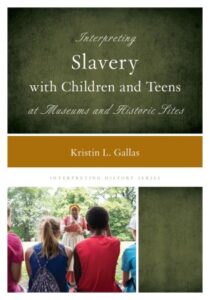Interpreting Slavery with Children and Teens at Museums and Historic Sites, by Kristin L. Gallas. Lanham, Maryland: Rowman & Littlefield, 2021.
REVIEWED BY REBECCA MCGOVERN
 Museums can be highly emotional places. History is a brutal landscape that holds countless traumas and pains for an unquantifiable number of people. This landscape is particularly poignant when addressing the history of slavery in America. These stories are invaluable and need to be shared—and museums act as their storyteller. But exactly how should museums approach sharing that story with children and teenagers? How do museums talk about deeply traumatic history without traumatizing students? This is the question Kristin L. Gallas tackles in Interpreting Slavery with Children and Teens at Museums and Historic Sites. The book acts as a training guide for historical sites and museums to follow, covering the related history, appropriate setting, and training necessary for slavery interpretation.
Museums can be highly emotional places. History is a brutal landscape that holds countless traumas and pains for an unquantifiable number of people. This landscape is particularly poignant when addressing the history of slavery in America. These stories are invaluable and need to be shared—and museums act as their storyteller. But exactly how should museums approach sharing that story with children and teenagers? How do museums talk about deeply traumatic history without traumatizing students? This is the question Kristin L. Gallas tackles in Interpreting Slavery with Children and Teens at Museums and Historic Sites. The book acts as a training guide for historical sites and museums to follow, covering the related history, appropriate setting, and training necessary for slavery interpretation.
Opening with the chapter “Race, Identity, and Historical Trauma,” Gallas does not water down the horrors of chattel slavery nor does she shy away from addressing white museum workers’ discomfort with approaching the topic. Gallas writes, “talking about race and the history of slavery is challenging, especially when you are talking with young people … our first instinct is often to ignore the subject altogether, but by disregarding it, we perpetuate a cycle in which young people learn to hide their feelings on the subject.” (Gallas 2021, 30) For Gallas, interpreters understanding how traumatic portrayals of slavery can be is a top priority. Aside from being historically informative, training functionally teaches interpreters to grow their own empathy and care for the topic. While Gallas is writing from a white perspective, she does not allow her voice to be the only one speaking through her work. She cites her conversations with numerous other museum workers, including Black professionals and historians who specialize in the nineteenth century.
The subsequent four chapters teach museums and sites how to lay a successful and safe foundation for students. These cover what defines a successful experience for guests, how to create a safe space for both staff and visitors, and what ages these training are targeting.
Each chapter establishes a foundation on which museums can build their theory of interpretation. In “Creating a Brave Space,” the importance of a sense of safety for guests and staff alike is laid out in explicit detail. Gallas argues that if your intention is for students to connect with history, you must have a staff that feels both confident and prepared to facilitate that connection. This means that staff need to know how to set boundaries with dialogue, address the institution’s own biases, know their audience, and eloquently address the discomfort of the audience. The chapter offers reasoning behind these requirements, citing practical experience from managerial staff from an array of historic sites.
However, this chapter best illustrates what is likely its largest fault. While the book is effective in providing well thought out advice for museums, it is also incredibly evident that Gallas is writing from the point of view of a manager. This is not an inherently bad thing, nor does it render all she recommends useless. However, her advice does put a lot of onus on the individual interpreters. Throughout, Gallas addresses expectations for proper interpretation directly to the interpreter. It is much less common for her to ask institutions to provide better training or mental health resources for staff. Her recommendations, while valuable and comprehensive in scope, would be more effectively applied on an institutional scale. Putting full responsibility on staff without proper training or institutional support is insufficient to fully achieve her goal.
“Staff Trainings and Support” is the second to last chapter and does partly address this criticism. This chapter addresses the massive duty for institutions to provide these trainings and addresses the undue expectation museums put on their “underpaid entry-level staff” (Gallas 2021, 146.) Gallas gives several examples of possible training, what-if scenarios, and scripts for managers to discuss with their staff. While the greatest expectation is still placed on the individual “underpaid entry-level staff,” there is an effort to bring these concerns on a wider scale.
With that criticism in mind, Interpreting Slavery with Children and Teens at Museums and Historic Sites is overall an incredibly helpful guide for museum workers who struggle with interpreting slavery and other traumatic topics. Gallas provides real world examples that feel relevant and creates a space of education without judgment. The advice provided is practically applicable and she covers topics like Fostering Empathy with care. The interpretation of slavery is vital for museums to ensure history does not continue to be told through a solely white perspective and that means that museum staff need to be able to discuss slavery safely and well. Guides like this one are a necessary part of museum education.
Rebecca McGovern is a first year MA student in the IU Indianapolis Museum Studies Program.

